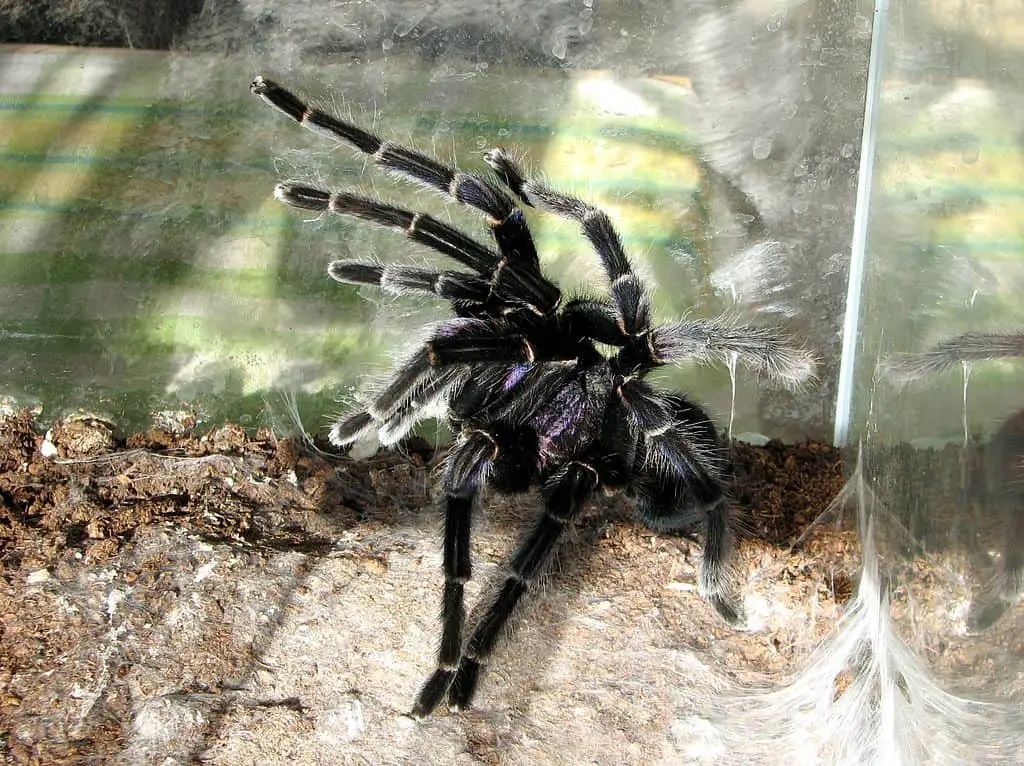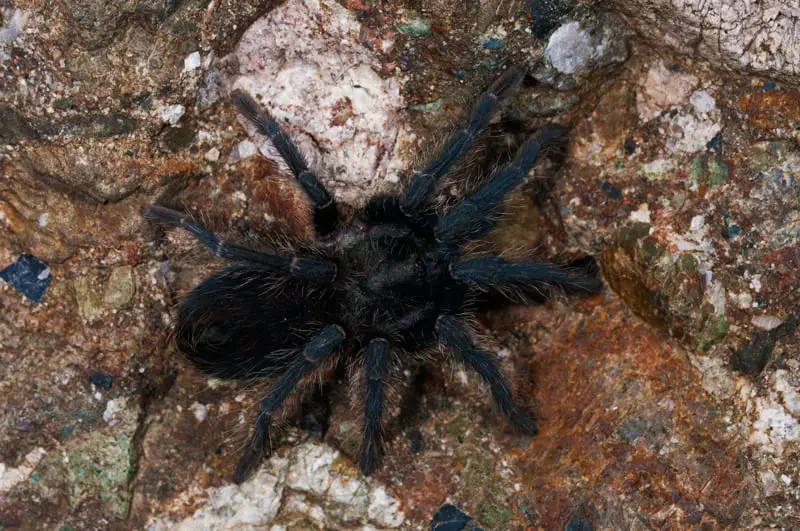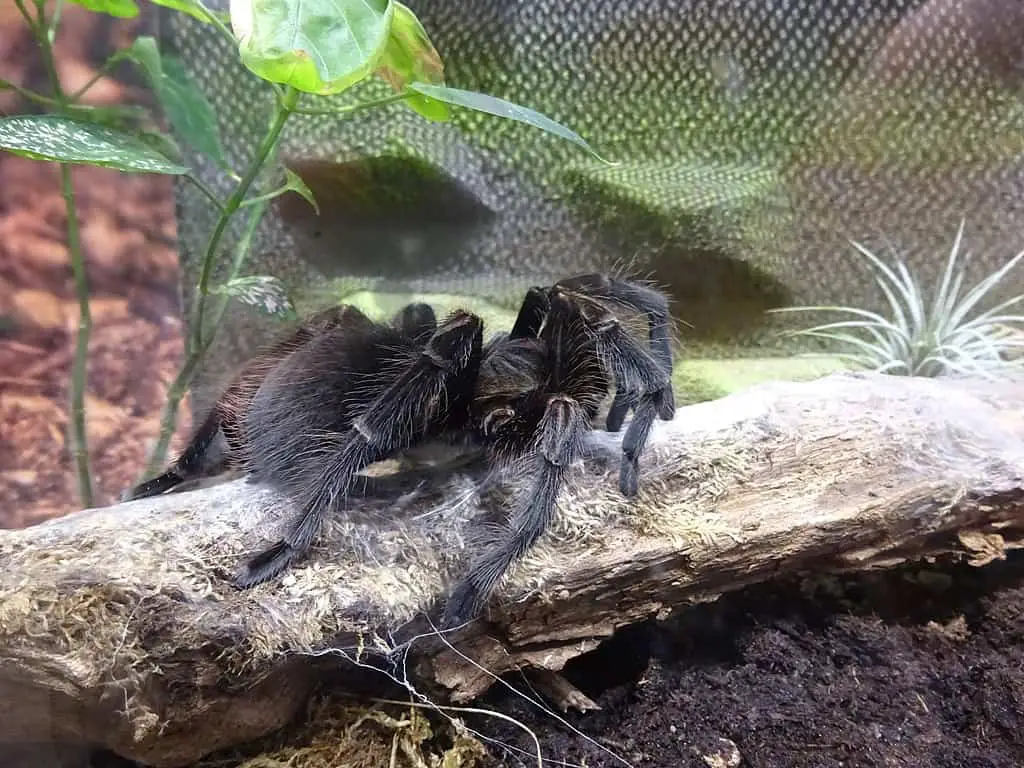The Hispaniolan Giant Tarantula (Phormictopus cancerides) is a terrestrial New World species from Haiti and the Dominican Republic. Most owners agree that it’s a highly underrated spider in the hobby.
With a reputation for being aggressive, flicking hairs, and having a strong venom, most hobbyists don’t see the appeal in owning one. However, they make for excellent display spiders, so experienced owners should be able to make the most of them.
In case you’re thinking of getting one of these beautiful spiders, we’ve gathered all the information you need to see if it’s the right fit for you.

Hispaniolan Giant Tarantula Care Sheet
| Name of Species | Phormictopus cancerides |
| Family | Theraphosidae |
| Common names | Hispaniolan Giant Tarantula |
| Native location | Hispaniola |
| Category | New World |
| Type | Terrestrial |
| Leg span | 8 inches |
| Growth speed | Fast |
| Urticating hairs | Yes, type I B |
| Diet | Insects, primarily roaches & crickets |
| Social | Solitary |
| Temperature | 76 to 82 °F |
| Humidity | 65 to 75% |
| Life span | Females: 15 to 20 years / Males 4 to 6 years |
| Experience level | Intermediate |
Hispaniola Giant Tarantula Overview

The Phormictopus cancerides is usually called the Hispaniolan Giant Tarantula by hobbyists. That’s the universal name, but she’s also called Haitian Brown Tarantula, Raignée-crab in Haiti, and Cacata in the Dominican Republic.
This terrestrial tarantula is called that way because it’s found in Haiti and the Dominican Republic, comprising the whole Hispaniolan territory.
For a New World tarantula, she’s defensive and prone to biting, so beginners should reconsider before getting one of these specimens.
Appearance
The Hispaniolan Giant Garantula may also receive the name Haitian Brown Tarantula, but it’s an undeserved name. This beautiful spider sports different colors: darker brown, copper, purplish brown, and reddish-brown tones.
They have dark bodies with bluish setae as spiderlings, displaying a blue shade until they become juveniles. Once the Hispaniolan Giant is a juvenile, and all the way to early adulthood, this tarantula will show plenty of purplish-brown and dark velvet-brown shades.
A bright line of copper is sometimes seen around the cephalothorax, but that’s not always visible. Adults will have toned-down versions of their juvenile appearance, sometimes only retaining pale blue over their abdomen and the bottom half of their legs.
Besides their changing appearance, the Hispaniolan Giant Tarantula doesn’t have a big difference between males and females besides size. The most reliable way to determine whether you have a male or a female is to take a look at their molt.
As their name suggests, they’re a large species, topping out at about 8 inches in leg span.
Price
The Hispaniolan Giant Tarantula is usually an inexpensive species with a good supply available worldwide.
Slings can be purchased for $20-$60, depending on where you get them.
Juvenile specimens range from $50 to $80, while male adults can rise to around $150.
Because of their longevity and size, adult females can sometimes increase to $350-$600 but can be found for less if you know where to look.
Behavior and Temperament
Even though the Hispianolian Giant Tarantula is a New World species, its behavior is more befitting of an Old World tarantula.
Defensive and aggressive, this tarantula will assume a threat posture without thinking twice about it if she feels threatened.
She’s also prone to biting, and with fangs that reach almost one inch, people on the receiving end of their bites know they’re painful.
As if bites weren’t scary enough with the sheer size of her fangs, the venom is also very painful to humans; however, while painful, their venom is not lethal and you should be alright as long as you’re not allergic.
Fangs aren’t the only thing you should be careful about, as this tarantula can also flick urticating setae.
The good news is that you’ll often see a threat posture before flicking hair, so you’re safe as long as you look for the signs.
Besides possible attacks, this beautiful tarantula likes to spend a lot of time in the open for a semi-fossorial species, so she’s an excellent display spider. They’re also decent webbers.
Due to their defensive nature and strong bites, these spiders are not a good match for beginners to the hobby.
Caring for a Hispaniolan Giant Tarantula

Temperature and Humidity
The Hispaniolan Giant Tarantula lives in a semitropical climate, with high humidity and temperatures that range from 74°F to 95°F in some regions.
These conditions make them a flexible and enduring spider; however, she’s most comfortable between 76°F to 82°F and with humidity of 65%-75%.
Substrate
The Hispaniolan Giant Tarantula usually doesn’t burrow as an adult, but she’ll spend plenty of time underground as a spiderling and juvenile.
In any case, three inches of substrate for spiderlings and three to four for adults should be enough.
As for the composition, a mixture of peat moss, vermiculite, and organic dirt will do wonders with them since they like moist soil.
A bottom layer of gravel for drainage will also do wonders, especially if you aim for a bioactive enclosure.
Tank
The Hispaniolan Giant Tarantula is a large species that will need tanks with volumes of at least ten gallons as adults. Being a terrestrial specimen, the tank should have more horizontal than vertical space to avoid falls that may harm them.
They’re also very strong, so you should have a safety lock in the tank to keep them from escaping. Considering the high humidity and climate they’re used to, it’s paramount to keep the tank well ventilated to avoid the growth of mold and bacteria.
As for the tank’s decoration, these New World spiders enjoy a bioactive enclosure with enough place to hide. Living plants, sphagnum moss, and a piece of bark for a hide will make your tarantula feel more comfortable. However, bioactive enclosures can be difficult to maintain. If you’re not ready to create a bioactive enclosure yet, make sure to provide her with hiding spaces, rocks, and some artificial plants.
A comfortable Hispaniolan Giant will spend more time out in the open and will be less skittish, so it’s in everyone’s best interest to make sure the enclosure has enough decoration.
Watering
The Hispaniolan Giant Tarantula enjoys humid and moist environments, especially when they’re spiderlings.
Keep the substrate moist by spraying it with water once a week.
You should also keep a water dish inside the enclosure in an accessible place. Make sure that the water bowl is always full.
Social
This species can not live communally and should be housed in a solitary enclosure. Communal housing will likely end in cannibalism.
Diet & Feeding
Having an aggressive spider usually comes with a benefit; they’re quick to jump on their food, which always makes for an interesting display. They can eat a variety of different insects, but should primarily eat crickets and roaches.
The Hispaniolan Giant Tarantula has a swift feeding response, sometimes even jumping over their prey when it gets within range.
Spiderlings will get the usual flightless fruit fly or small cricket two times per week.
As juveniles, you should feed them a medium cricket every week.
Adults, with their huge size and voracious appetite, should eat two large B. dubia roaches or seven adult crickets every week or so.
The only time they’ll ever reject food is when they’re just about to molt, and you shouldn’t feed them right afterward either until their fangs are hard enough for them to start eating again.
Their growth speed usually slows down as they become juveniles, so make sure to examine their abdomens as you slowly increase their portions to make sure you’re not overfeeding or underfeeding them.
Fun Facts about the Hispaniolan Giant Tarantula
- Even though she has a reputation for being aggressive, some owners claim their specimens are more on the skittish side. If you get lucky, you may get a Hispaniolan Giant Tarantula that tries to run to safety instead of attempting to bite you.
- Some Phormictopus cancerides specimens maintain a strong purplish coloration in their adulthood. This is more common among males, and it’s a rare occurrence but completely possible within the species. However, you shouldn’t confuse them with the Phormictopus sp. purple, a different species with an even stronger purple coloration.
- The Phormictopus cancerides has a close cousin on the same island, the Phormictopus atrichomatus. Both species are so similar that sometimes you may buy a P. cancerides and get a P. atrichomatus by mistake.
Final words
The Hispaniolan Giant tarantula is not a great fit for beginners due to its temperament and potent venom. Beginners are better off gaining confidence and experience handling large spiders with more docile species such as the Mexican Red Knee or Purple Pinktoe first.
However, for intermediate hobbyists, this species should not be overlooked.
This underrated New World tarantula should be in more collections than she is. With proper care, she’s a sturdy and reliable tarantula that works great as a display spider. We hope this article gave you all the information you need to make the right decision.
- How Long Do American Eskimo Dogs Live? Important Factors and Care Tips - September 29, 2023
- Do American Bulldogs Need Grooming? Essential Tips and Care Guidelines - September 29, 2023
- Do Bengal Cats Enjoy Playing? Essential Tips for Keeping Them Active - September 29, 2023